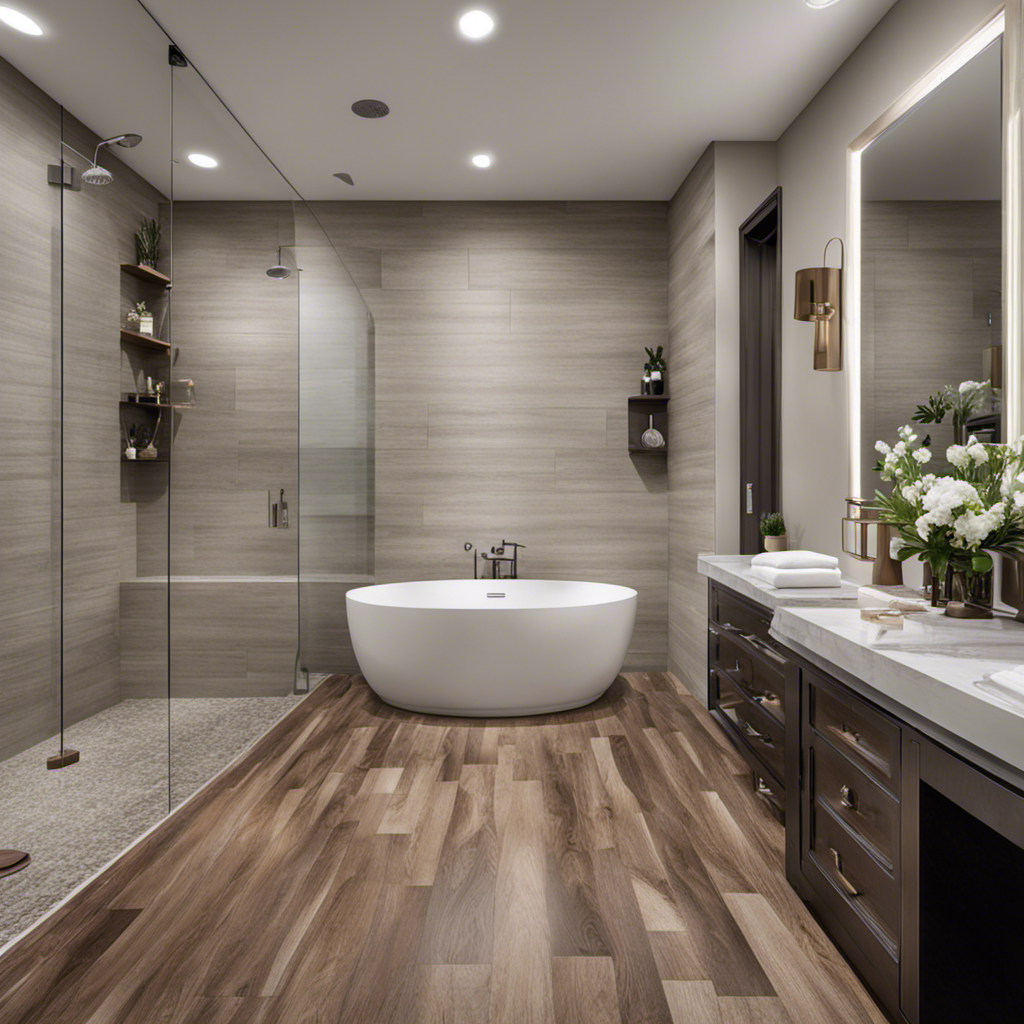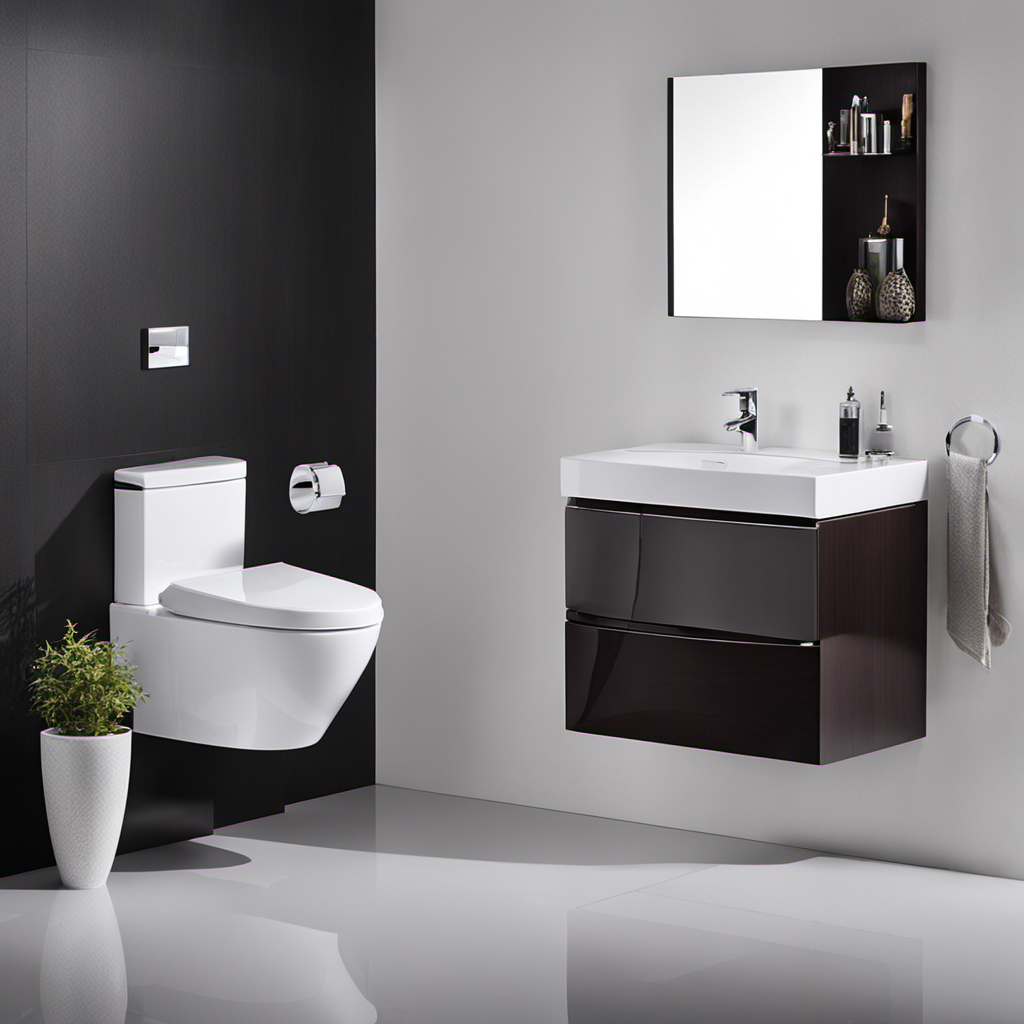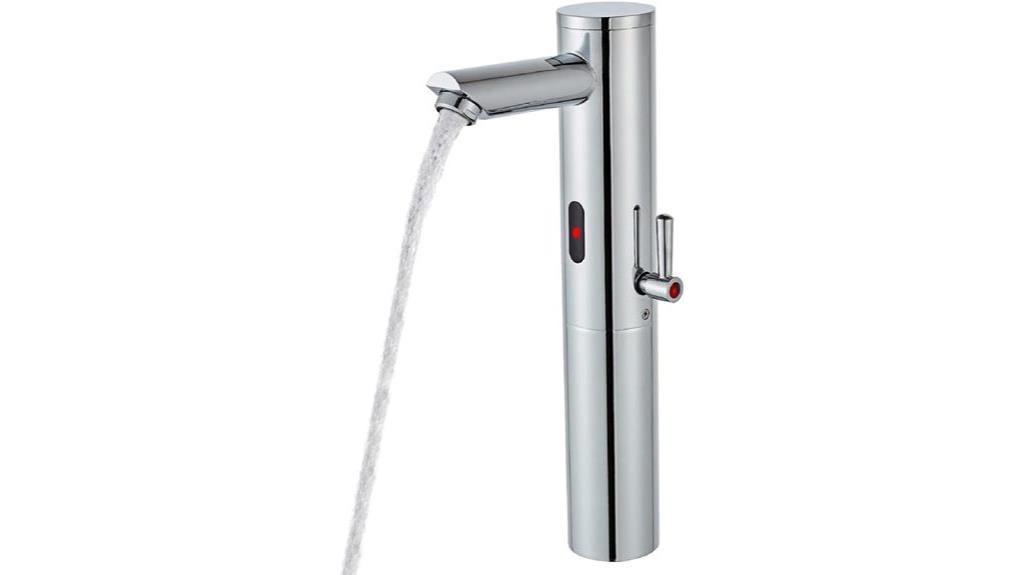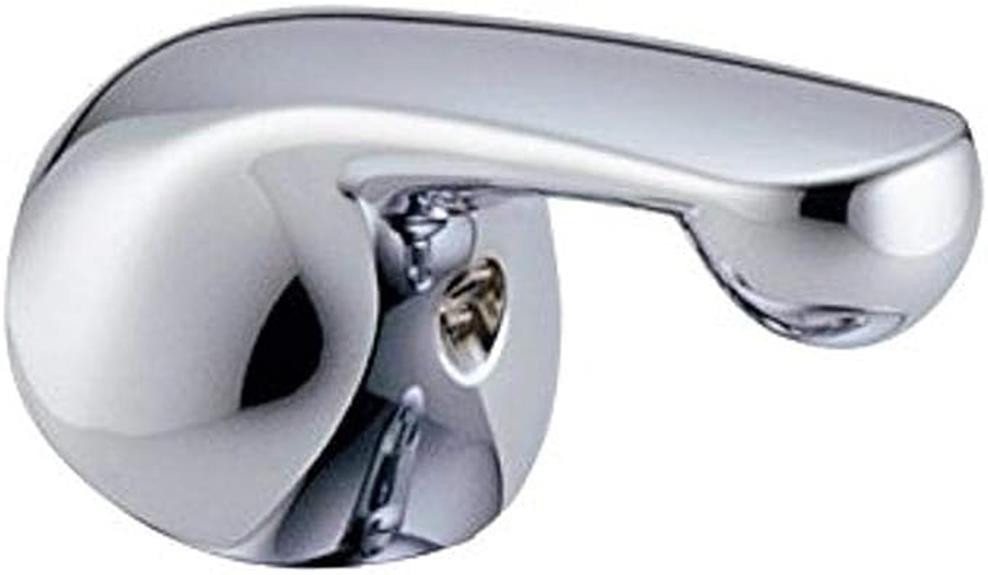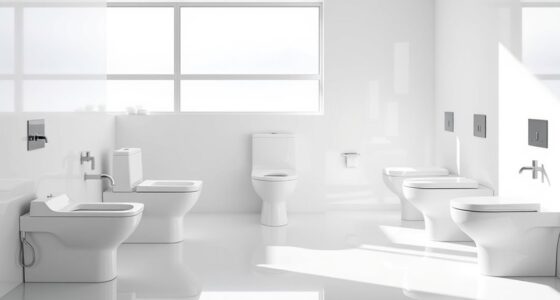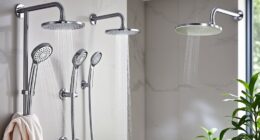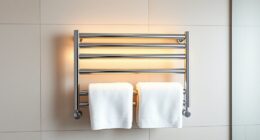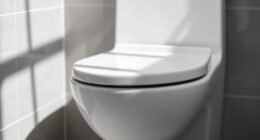When it comes to choosing the best bathroom flooring, I must say that the options are plentiful. From solid hardwood to engineered hardwood, laminate, vinyl, tile, rubber, and even carpet, there’s something for every style and preference.
Each type of flooring has its own set of pros and cons, but one thing is for sure – you’ll find the perfect flooring that combines durability, moisture resistance, and easy maintenance.
So, let’s dive into the world of bathroom flooring options and discover the one that suits your needs best.
Key Takeaways
- Solid hardwood flooring is not recommended for bathrooms due to its susceptibility to moisture damage.
- Engineered hardwood is a strong and attractive option for bathroom flooring, as it is better with moisture or humidity compared to solid hardwood.
- Laminate and vinyl flooring are affordable options for those on a budget, with laminate offering a wide range of designs and styles and vinyl being water and stain-resistant.
- Tile flooring, particularly ceramic and porcelain tiles, are durable, low maintenance, and water-resistant options for bathroom flooring.
Solid Hardwood Flooring
Solid hardwood flooring is not recommended for bathrooms due to its susceptibility to moisture damage. However, it offers a timeless and elegant look to any other room in the house.
When it comes to solid hardwood maintenance, it’s important to keep the flooring dry and clean. Regular sweeping or vacuuming, along with occasional damp mopping using a hardwood floor cleaner, will help maintain its beauty. It’s crucial to avoid excessive moisture exposure and wipe up any spills immediately to prevent water damage.
On the other hand, engineered hardwood is a great alternative for bathrooms. Its construction with multiple layers makes it more resistant to moisture and humidity compared to solid hardwood.
When installing engineered hardwood, it’s important to follow proper installation techniques, such as acclimating the flooring to the room’s temperature and humidity levels before installation. This ensures a stable and long-lasting floor.
Engineered Hardwood Flooring
I really like how engineered hardwood flooring offers a strong and attractive option for my bathroom. The durability of engineered hardwood makes it a great choice for areas with high moisture levels, such as bathrooms. Unlike solid hardwood flooring, engineered hardwood is better equipped to handle moisture and humidity without warping or staining.
The installation process for engineered hardwood flooring is also relatively straightforward. It can be installed as a floating floor, which means it does not need to be glued or nailed down. This makes the installation process easier and more convenient.
Here is a table outlining the key features of engineered hardwood flooring:
| Engineered Hardwood Flooring |
|---|
| Durability |
| Moisture resistance |
| Attractive design |
| Easy installation |
Overall, engineered hardwood flooring is a durable and beautiful option for bathrooms. Its ability to withstand moisture and its relatively easy installation process make it a popular choice among homeowners.
Laminate Flooring
Laminate flooring offers a wide range of design and style options for my bathroom. One of the main advantages of laminate flooring is its affordability, making it a great choice for those on a tight budget. Not only does it come in a variety of designs and styles, but it is also easy to clean with a simple mop or broom.
Laminate flooring is known for its durability and can last for decades with proper care and maintenance. To keep it looking its best, it is important to avoid excessive moisture and to promptly clean up any spills. Regular sweeping or vacuuming, along with occasional damp mopping, will help maintain its appearance.
With proper care and maintenance, laminate flooring can provide a beautiful and long-lasting solution for my bathroom.
Vinyl Flooring
Vinyl flooring offers a cost-effective and water-resistant solution for my bathroom. It is a versatile option that comes in various styles and designs, allowing me to choose the perfect look for my space. When it comes to vinyl flooring, there are two main types to consider: vinyl plank and vinyl sheet.
Vinyl plank flooring provides the look of real wood with its realistic wood grain patterns. It comes in planks that easily click together, making installation a breeze. On the other hand, vinyl sheet flooring comes in large rolls and is best suited for larger areas. It offers a seamless look and can be easily cut to fit any space.
When installing vinyl flooring, there are a few tips to keep in mind. First, make sure the subfloor is clean, smooth, and dry. Any imperfections can affect the final result. Second, acclimate the vinyl to the room’s temperature and humidity levels before installation. This will prevent any expansion or contraction issues. Finally, use a sharp utility knife to cut the vinyl to the desired size and shape.
Tile Flooring
Tile flooring offers a wide range of options in terms of design, durability, and maintenance.
One of the advantages of tile flooring is its ability to resist stains and water damage. Ceramic tiles, for example, are known for their stain and water-resistant properties. Additionally, porcelain tiles are non-porous and moisture-resistant, making them a great choice for bathrooms.
Another advantage of tile flooring is its durability. Properly installed and sealed, tiles can withstand heavy foot traffic and last for many years.
However, one disadvantage of tile flooring is the meticulous and time-consuming installation process. It requires precise measurements, cutting, and grouting. Additionally, natural stone tiles can be difficult to clean and are not suitable for shower sections.
Despite these disadvantages, tile flooring remains a popular and practical choice for bathrooms due to its aesthetic appeal and long-lasting durability.
Rubber Flooring
I find it fascinating that rubber flooring is gaining popularity as a durable and eco-friendly option for bathrooms. Rubber flooring installation offers several benefits that make it a great choice for this space:
-
Easy Installation: Rubber flooring is available in tiles or sheets, making it easy to install. It can be glued down or installed as a floating floor, saving time and effort during the installation process.
-
Durability: Rubber flooring is highly resistant to wear and tear, making it ideal for high-traffic areas like bathrooms. It can withstand heavy foot traffic, moisture, and heat without losing its integrity.
-
Slip-Resistance: Rubber flooring provides excellent traction, reducing the risk of slips and falls in wet bathroom environments. The texture of rubber flooring helps to create a stable and secure surface.
-
Eco-Friendly: Rubber flooring is made from recycled rubber, reducing the demand for new materials. It is a sustainable choice that contributes to a healthier environment.
Overall, rubber flooring offers a practical and environmentally conscious solution for bathroom flooring. Its durability, ease of installation, slip-resistance, and eco-friendly nature make it a top choice for homeowners.
Carpet Flooring
When considering bathroom flooring, it’s important to explore all available options, such as carpet flooring.
Carpet bathroom flooring offers opulence and luxury to the bathroom while adding style and maintenance to the space.
The installation of carpet flooring in the bathroom requires careful consideration. It is essential to choose a carpet that is specifically designed for high-moisture areas, ensuring durability and water resistance.
Additionally, selecting the right color for your carpet flooring is crucial in achieving the desired aesthetic for your bathroom. There are various color options available to suit different styles and preferences, ranging from neutral tones to bold and vibrant shades.
Whether you prefer a cozy and warm atmosphere or a sleek and modern look, carpet flooring provides versatility and comfort underfoot.
Pros and Cons of Solid Hardwood
One of the pros of solid hardwood is its natural beauty and timeless appeal. It adds a touch of elegance and sophistication to any bathroom.
Here are some important points to consider about solid hardwood flooring:
-
Moisture Resistance: Solid hardwood is not recommended for bathrooms due to its susceptibility to moisture damage. It is not waterproof and can stain or warp when exposed to water.
-
Termite Attraction: Moist wood can attract termites, which can lead to costly repairs and damage. Proper sealing and maintenance are necessary to prevent termite infestations.
-
Durability: Solid hardwood is known for its durability and longevity. With proper care and maintenance, it can last for decades, adding value to your home.
-
Aesthetics: Solid hardwood offers a timeless and classic look that never goes out of style. It comes in a variety of species, colors, and finishes, allowing you to create a unique and personalized bathroom space.
Pros and Cons of Engineered Hardwood
After researching the pros and cons, I’ve found that engineered hardwood flooring is a strong and attractive option for bathroom floors.
Engineered hardwood is made with real wood and multiple layers, providing durability and aesthetic appeal.
One advantage of engineered hardwood is its ability to handle moisture and humidity better than solid hardwood. This makes it a suitable choice for bathroom environments where water exposure is common.
Additionally, engineered hardwood comes in a variety of styles, colors, species, and designs, allowing for customization to match any bathroom decor.
However, it’s important to note that engineered hardwood still requires proper sealing to prevent water damage.
Despite this disadvantage, its overall strength and beauty make it a popular choice for bathroom flooring.
Pros and Cons of Laminate and Vinyl
I found that both laminate and vinyl flooring offer a wide range of designs and styles to choose from. When comparing the two, there are some key factors to consider in terms of durability and maintenance.
Durability:
Laminate flooring is known for its durability and can withstand heavy foot traffic and everyday wear and tear. Vinyl flooring is also highly durable and can resist scratches, stains, and water damage, making it a great option for bathrooms.
Maintenance:
Laminate flooring is easy to clean and maintain, requiring only basic mopping or sweeping to keep it looking its best. Vinyl flooring is also low maintenance and can be easily wiped clean with a damp cloth or mop.
Comparison:
In terms of durability, both laminate and vinyl flooring are excellent choices. However, laminate flooring may be more prone to water damage if not properly sealed, while vinyl flooring is waterproof and more resistant to moisture.
Overall, both laminate and vinyl flooring offer durability and low maintenance, making them popular choices for bathroom flooring. The decision ultimately comes down to personal preference and the specific needs of your space.
Pros and Cons of Tile, Rubber, and Carpet
When considering tile, rubber, and carpet for my bathroom, it is important to weigh the pros and cons of each option.
Tile flooring offers numerous advantages. It is stain and water-resistant, making it durable and low maintenance. The installation process can be meticulous, but proper sealing prevents water damage.
On the other hand, rubber flooring has its disadvantages. While it is gaining popularity due to its slip-resistant and eco-friendly nature, it can be difficult to clean and maintain. Additionally, rubber flooring may not offer the same level of elegance and style as other options.
It is crucial to consider these factors when making a decision for my bathroom flooring. Ultimately, the choice will depend on my personal preferences and priorities.
Frequently Asked Questions
Is Solid Hardwood Flooring a Suitable Option for Bathrooms With High Moisture Levels?
No, solid hardwood flooring is not suitable for bathrooms with high moisture levels. It is prone to damage from water and requires regular maintenance. There are alternative bathroom flooring options that are more resistant to moisture.
Can Laminate Flooring Be Installed in a Bathroom With a Shower?
Yes, laminate flooring can be installed in a bathroom with a shower. It is durable and offers water resistance. However, proper sealing or installation is necessary to prevent water damage.
What Are the Benefits of Rubber Bathroom Flooring Over Other Types of Flooring Options?
Rubber bathroom flooring offers many benefits compared to other flooring options. It is durable and can withstand moisture and heat. The installation process for rubber flooring is straightforward, making it an excellent choice for bathrooms.
Is Carpet Bathroom Flooring Easy to Clean and Maintain?
Carpet bathroom flooring is easy to clean and maintain. It offers durability and a wide range of design options. However, it requires regular vacuuming and occasional professional cleaning to keep it looking its best.
What Are the Pros and Cons of Using Vinyl Flooring in a Bathroom Compared to Tile Flooring?
Vinyl flooring in a bathroom has advantages over tile flooring. It is durable and can withstand moisture. The installation process is easier and quicker compared to tile. However, tile offers a more traditional and elegant look.
Conclusion
In conclusion, when it comes to choosing the best bathroom flooring, there are several options to consider.
Solid hardwood flooring is not recommended due to its vulnerability to moisture damage.
Engineered hardwood is a strong and attractive alternative that can withstand moisture and humidity better.
Laminate and vinyl flooring are affordable and easy to maintain.
Tile flooring, such as ceramic and porcelain, is stain and water-resistant, while natural stone tiles provide a rustic and elegant look.
Rubber flooring is gaining popularity for its slip-resistant and eco-friendly properties.
Lastly, carpet flooring adds luxury and comfort to the bathroom.
One interesting statistic to note is that according to a recent survey, 75% of homeowners prefer tile flooring in their bathrooms. This is due to its durability and water-resistant properties, making it a popular choice for many.
